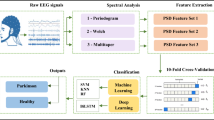Abstract
Parkinson’s disease (PD) affects over 10 million people worldwide. Tremors, stiffness, voice changes, delayed movement, and difficulty walking are typical symptoms of the condition. In the early stage of the disease, these symptoms are difficult to identify and therefore it becomes increasingly important and necessary to be able to predict Parkinson’s and diagnose it as soon as possible. In particular, more studies have focused on the differences found in the electroencephalogram (EEG) of patients with PD. The EEG is used to measure the electrical activity of the brain. The detection of unusual signals is indicative of a pathological condition such as Parkinson’s. This work proposes a new way of researching the diagnosis and surveillance of PD. The results are satisfactory and better when compared with those of other studies conducted on the same data. This indicates that the proposed method can effectively improve early Parkinson’s diagnosis by reducing the time and effort required.
Access this chapter
Tax calculation will be finalised at checkout
Purchases are for personal use only
Similar content being viewed by others
Notes
References
Aversano, L., et al.: Using machine learning for classification of cancer cells from raman spectroscopy. In: Proceedings of the 3rd International Conference on Deep Learning Theory and Applications, DeLTA 2022, Lisbon, Portugal, 12–14 July 2022, pp. 15–24. SCITEPRESS (2022)
Aversano, L., et al.: Thyroid disease treatment prediction with machine learning approaches. Procedia Comput. Sci. 192, 1031–1040 (2021)
Aversano, L., Bernardi, M.L., Cimitile, M., Iammarino, M., Montano, D., Verdone, C.: A machine learning approach for early detection of Parkinson’s disease using acoustic traces. In: 2022 IEEE International Conference on Evolving and Adaptive Intelligent Systems (EAIS), pp. 1–8. IEEE (2022)
Aversano, L., Bernardi, M.L., Cimitile, M., Iammarino, M., Montano, D., Verdone, C.: Using machine learning for early prediction of heart disease. In: 2022 IEEE International Conference on Evolving and Adaptive Intelligent Systems (EAIS), pp. 1–8. IEEE (2022)
Aversano, L., Bernardi, M.L., Cimitile, M., Iammarino, M., Verdone, C.: Early detection of Parkinson’s disease using spiral test and echo state networks. In: 2022 International Joint Conference on Neural Networks (IJCNN), pp. 1–8 (2022)
Aversano, L., Bernardi, M.L., Cimitile, M., Iammarino, M., Verdone, C.: An enhanced UNet variant for effective lung cancer detection. In: 2022 International Joint Conference on Neural Networks (IJCNN), pp. 1–8 (2022)
Aversano, L., Bernardi, M.L., Cimitile, M., Pecori, R.: Early detection of Parkinson disease using deep neural networks on gait dynamics. In: 2020 International Joint Conference on Neural Networks (IJCNN), pp. 1–8. IEEE (2020)
Aversano, L., Bernardi, M.L., Cimitile, M., Pecori, R.: Fuzzy neural networks to detect Parkinson disease. In: 2020 IEEE International Conference on Fuzzy Systems (FUZZ-IEEE), pp. 1–8. IEEE (2020)
Brownlee, J.: How to grid search hyperparameters for deep learning models in python with keras. Linea (2016)
Chaturvedi, M., et al.: Quantitative EEG (QEEG) measures differentiate Parkinson’s disease (PD) patients from healthy controls (HC). Front. Aging Neurosci. 9, 3 (2017)
Chawla, N.V., Bowyer, K.W., Hall, L.O., Kegelmeyer, W.P.: Smote: synthetic minority over-sampling technique. J. Artif. Intell. Res. 16, 321–357 (2002)
Goetz, C.G., et al.: Movement disorder society-sponsored revision of the unified Parkinson’s disease rating scale (MDS-UPDRS): scale presentation and clinimetric testing results. Move. Disord.: Off. J. Move. Disord. Soc. 23(15), 2129–2170 (2008)
Koch, M., Geraedts, V., Wang, H., Tannemaat, M., Bäck, T.: Automated machine learning for EEG-based classification of Parkinson’s disease patients. In: 2019 IEEE International Conference on Big Data (Big Data), pp. 4845–4852 (2019)
Miller, A.M., et al.: Effect of levodopa on electroencephalographic biomarkers of the parkinsonian state. J. Neurophysiol. 122(1), 290–299 (2019)
Twelves, D., Perkins, K.S., Counsell, C.: Systematic review of incidence studies of Parkinson’s disease. Move. Disord.: Off. J. Move. Disord. Soc. 18(1), 19–31 (2003)
Van Den Eeden, S.K., et al.: Incidence of Parkinson’s disease: variation by age, gender, and race/ethnicity. Am. J. Epidemiol. 157(11), 1015–1022 (2003)
Vanegas, M.I., Ghilardi, M.F., Kelly, S.P., Blangero, A.: Machine learning for EEG-based biomarkers in Parkinson’s disease. In: 2018 IEEE International Conference on Bioinformatics and Biomedicine (BIBM), pp. 2661–2665 (2018)
Vanneste, S., Song, J.-J., De Ridder, D.: Thalamocortical dysrhythmia detected by machine learning. Nat. Commun. 9(1), 1–13 (2018)
Yuvaraj, R., Rajendra Acharya, U., Hagiwara, Y.: A novel Parkinson’s disease diagnosis index using higher-order spectra features in EEG signals. Neural Comput. Appl. 30(4), 1225–1235 (2018)
Author information
Authors and Affiliations
Corresponding author
Editor information
Editors and Affiliations
Rights and permissions
Copyright information
© 2023 The Author(s), under exclusive license to Springer Nature Switzerland AG
About this paper
Cite this paper
Aversano, L., Bernardi, M.L., Cimitile, M., Iammarino, M., Montano, D., Verdone, C. (2023). Early Parkinson’s Disease Detection from EEG Traces Using Machine Learning Techniques. In: Massanet, S., Montes, S., Ruiz-Aguilera, D., González-Hidalgo, M. (eds) Fuzzy Logic and Technology, and Aggregation Operators. EUSFLAT AGOP 2023 2023. Lecture Notes in Computer Science, vol 14069. Springer, Cham. https://doi.org/10.1007/978-3-031-39965-7_50
Download citation
DOI: https://doi.org/10.1007/978-3-031-39965-7_50
Published:
Publisher Name: Springer, Cham
Print ISBN: 978-3-031-39964-0
Online ISBN: 978-3-031-39965-7
eBook Packages: Computer ScienceComputer Science (R0)




